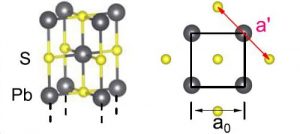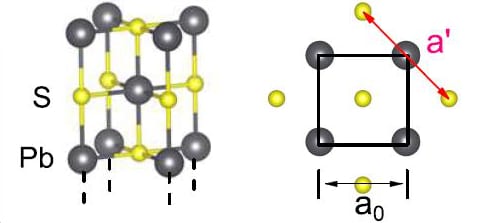
The side view (left), and the top view (right) of a PbS (001) few layer. More here.
There is presently a major effort in materials sciences to explore the unique properties of 2D materials. On the one hand, controllable valley degrees of freedom enrich the physical properties of few-layer graphene and transition-metal dichalcogenides, on which novel technologies than become promising. On the other hand, topological properties such as the quantum spin Hall effects in HgTe/CdTe and InAs/GaSb quantum wells open new avenues for fundamental physics and low-power electronics. However, none of these experimentally accessible 2D systems exhibit both prominent valleytronic and topological hallmarks.
The dual-valley PbS monolayer is demonstrated to be a novel platform for exploring topological and valleytronic phenomena by a joint team led by Prof. Yugui Yao (Beijing Institute of Technology) and Prof. Fan Zhang (University of Texas at Dallas), discussed in a recent article in Advanced Materials. The bandgaps of PbS few-layers cover a wide spectrum from the infrared to visible, making them promising for optoelectronics. Intriguingly, although the PbS few-layers are normal insulators, compressive strain can conveniently turn the monolayer into quantum spin Hall insulators. This feature may be utilized for mechanically controlled low-power electronic devices. Furthermore, in spite of the vanishing elliptic dichroism due to the inversion symmetry in the monolayer, optical pumping provides an efficient tool to characterize the topologically distinct phases and to facilitate the realization of charge, spin, and valley Hall effects in optoelectronic transport. Such transport can be tunable by external strain and light ellipticity. Similar results apply to other IV–VI semiconductors.
Notably, PbS few-layers and SnTe bilayers have already been successfully synthesized. The new theoretical predictions on monolayer PbS immediately advance the current knowledge of 2D quantum materials, offer a unique platform for exploring novel topological, valleytronic, and optical phenomena, and will have a significant impact on many exciting experiments in the future.

















